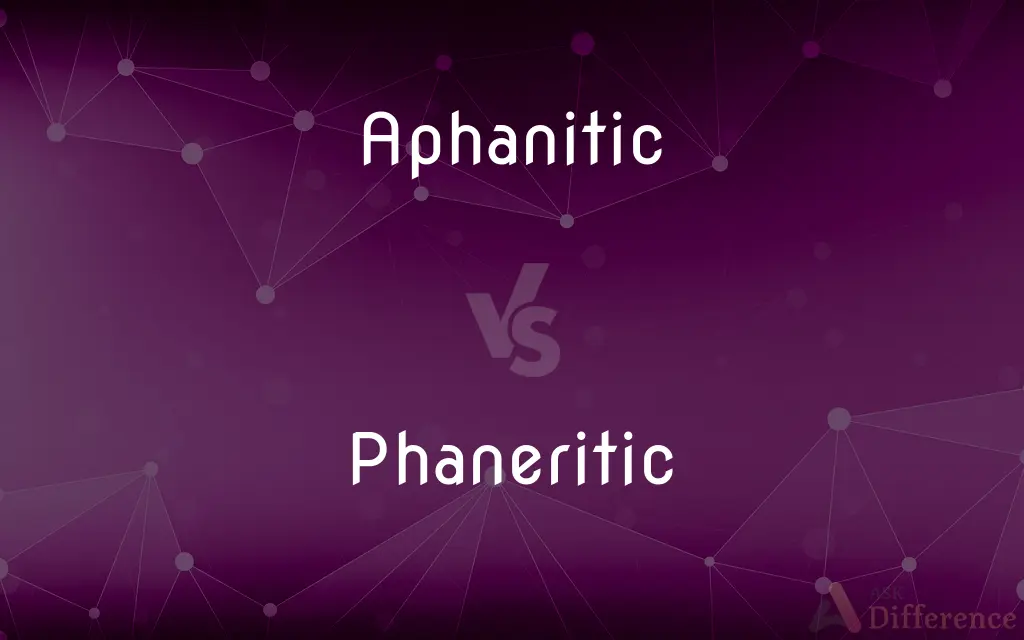Aphanitic vs. Phaneritic — What's the Difference?
By Tayyaba Rehman & Urooj Arif — Updated on March 21, 2024
Aphanitic rocks have fine-grained textures not visible to the naked eye, typical of fast-cooling lava. Phaneritic rocks are coarse-grained, with minerals visible to the naked eye, indicating slow cooling within the Earth.

Difference Between Aphanitic and Phaneritic
Table of Contents
ADVERTISEMENT
Key Differences
Aphanitic texture in igneous rocks is characterized by its fine-grained structure, where individual minerals are too small to be distinguished without magnification. This texture forms when magma or lava cools rapidly at or near the Earth's surface, leaving insufficient time for large crystals to grow. In contrast, phaneritic texture features large, easily identifiable mineral grains that crystallize slowly from magma deep within the Earth's crust. The slow cooling process allows ions in the magma enough time to arrange into well-formed crystals, resulting in a coarse-grained appearance.
The formation environment is a key differentiator between aphanitic and phaneritic textures. Aphanitic rocks, such as basalt, typically form from lava flows exposed to the atmosphere or ocean, which accelerates cooling. Phaneritic rocks, like granite, form from magma that cools slowly beneath the Earth's surface, insulated by surrounding rock. This environment facilitates the growth of large crystals.
In terms of identification and study, aphanitic rocks may require microscopic examination or other analytical techniques to determine their mineral composition, due to the fine-grained texture. Phaneritic rocks, however, can often be studied with the naked eye or a hand lens, allowing geologists to easily identify and classify them based on the visible minerals.
Both aphanitic and phaneritic textures provide valuable information about the geological history of an area, including the cooling rate and environment of the magma or lava from which they formed. While aphanitic rocks hint at volcanic activity and rapid cooling events, phaneritic rocks suggest a history of slow cooling within the Earth's crust, often associated with the formation of large igneous bodies like batholiths.
Comparison Chart
Grain Size
Fine-grained, not visible to the naked eye
Coarse-grained, visible to the naked eye
ADVERTISEMENT
Cooling Rate
Rapid cooling
Slow cooling
Formation Environment
At or near the Earth's surface (volcanic activity)
Deep within the Earth's crust
Typical Rocks
Basalt, andesite
Granite, gabbro
Mineral Identification
Requires magnification
Possible with the naked eye or hand lens
Compare with Definitions
Aphanitic
Results from quick cooling of magma or lava.
The aphanitic texture of andesite indicates its volcanic origin.
Phaneritic
Features a coarse-grained texture with minerals visible to the naked eye.
Granite, a common phaneritic rock, showcases visible quartz and feldspar.
Aphanitic
Not allowing crystal growth large enough for the naked eye.
Aphanitic rocks often require thin sections for mineral identification.
Phaneritic
Indicates slow cooling of magma deep within the crust.
The phaneritic texture of gabbro reveals its intrusive origins.
Aphanitic
Characterized by a fine-grained texture, not visible without magnification.
Basalt is an aphanitic rock formed from rapid lava cooling.
Phaneritic
Associated with plutonic rock formations.
Large batholiths typically consist of phaneritic textured rocks.
Aphanitic
Common in volcanic rocks.
Many volcanic islands feature aphanitic rock formations.
Phaneritic
Reflects a deep, insulated cooling environment.
The coarse grains in phaneritic rocks indicate a long period of crystallization underground.
Aphanitic
Indicates surface or near-surface formation.
Aphanitic textures suggest a rock solidified quickly, likely at the Earth's surface.
Phaneritic
Allows for easy mineral identification and classification.
Phaneritic rocks like diorite are studied using hand lenses for mineralogy.
Aphanitic
A dense, homogeneous rock with constituents so fine that they cannot be seen by the naked eye.
Phaneritic
Of or relating to an igneous rock in which the crystals are so coarse that individual minerals can be distinguished with the naked eye.
Aphanitic
Pertaining to aphanites, igneous rocks composed of microscopic mineral crystals (fine grains too small to be visible to the naked eye.
Phaneritic
Pertaining to phanerites, igneous rocks composed of macroscopic mineral crystals (coarse grains large enough to be visible to the naked eye).
Aphanitic
Resembling aphanite; having a very fine-grained structure.
Aphanitic
Of or relating to aphanite
Common Curiosities
What does the presence of aphanitic rocks indicate about an area's geological history?
The presence of aphanitic rocks indicates rapid cooling, often associated with volcanic activity and surface or near-surface magma solidification.
Where do phaneritic rocks typically form?
Phaneritic rocks typically form deep within the Earth's crust, where magma cools slowly, allowing large crystals to grow.
How can you distinguish between aphanitic and phaneritic rocks?
Aphanitic rocks are distinguished by their fine-grained texture, requiring magnification for mineral identification, while phaneritic rocks are coarse-grained, with minerals visible to the naked eye.
Why are phaneritic textures important in geology?
Phaneritic textures are important because they indicate a slow cooling process deep within the Earth, providing insights into the history of igneous rock formation and the geological processes at work.
Can the texture of a rock change from aphanitic to phaneritic?
The texture of a rock itself doesn't change from aphanitic to phaneritic or vice versa; instead, different cooling rates of magma or lava lead to the formation of rocks with either texture.
What are some applications of studying aphanitic and phaneritic textures?
Studying these textures helps geologists understand volcanic activity, the movement of tectonic plates, and the conditions under which different types of igneous rocks form.
What defines an aphanitic rock texture?
An aphanitic texture is defined by its fine-grained structure, where individual minerals are too small to be seen without magnification, indicating rapid cooling.
How does the cooling rate affect the texture of igneous rocks?
The cooling rate directly affects the texture: rapid cooling results in fine-grained aphanitic textures, while slow cooling allows for the growth of large crystals, resulting in a coarse-grained phaneritic texture.
Are there rocks with both aphanitic and phaneritic textures?
Yes, some rocks may exhibit both textures, often due to complex cooling histories where part of the magma cools rapidly while another part cools slowly.
What tools are used to study these rock textures?
Geologists use magnifying tools like hand lenses or microscopes to study aphanitic textures and the naked eye or low-magnification tools for phaneritic textures.
Share Your Discovery

Previous Comparison
Humanity vs. Humanism
Next Comparison
Algebra vs. TrigonometryAuthor Spotlight
Written by
Tayyaba RehmanTayyaba Rehman is a distinguished writer, currently serving as a primary contributor to askdifference.com. As a researcher in semantics and etymology, Tayyaba's passion for the complexity of languages and their distinctions has found a perfect home on the platform. Tayyaba delves into the intricacies of language, distinguishing between commonly confused words and phrases, thereby providing clarity for readers worldwide.
Co-written by
Urooj ArifUrooj is a skilled content writer at Ask Difference, known for her exceptional ability to simplify complex topics into engaging and informative content. With a passion for research and a flair for clear, concise writing, she consistently delivers articles that resonate with our diverse audience.
















































